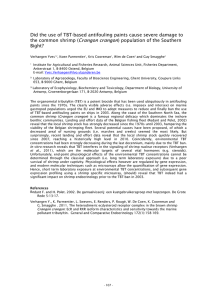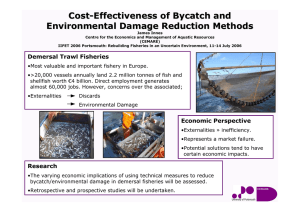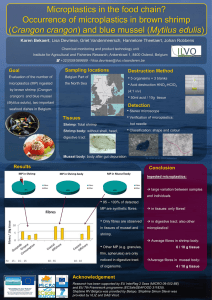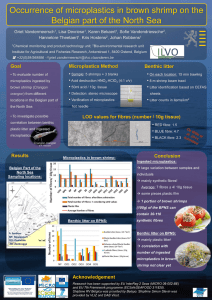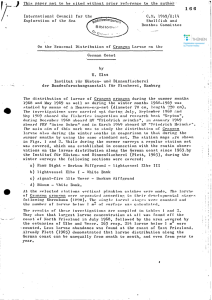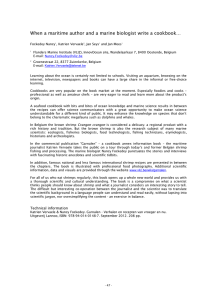Document 12411016
advertisement
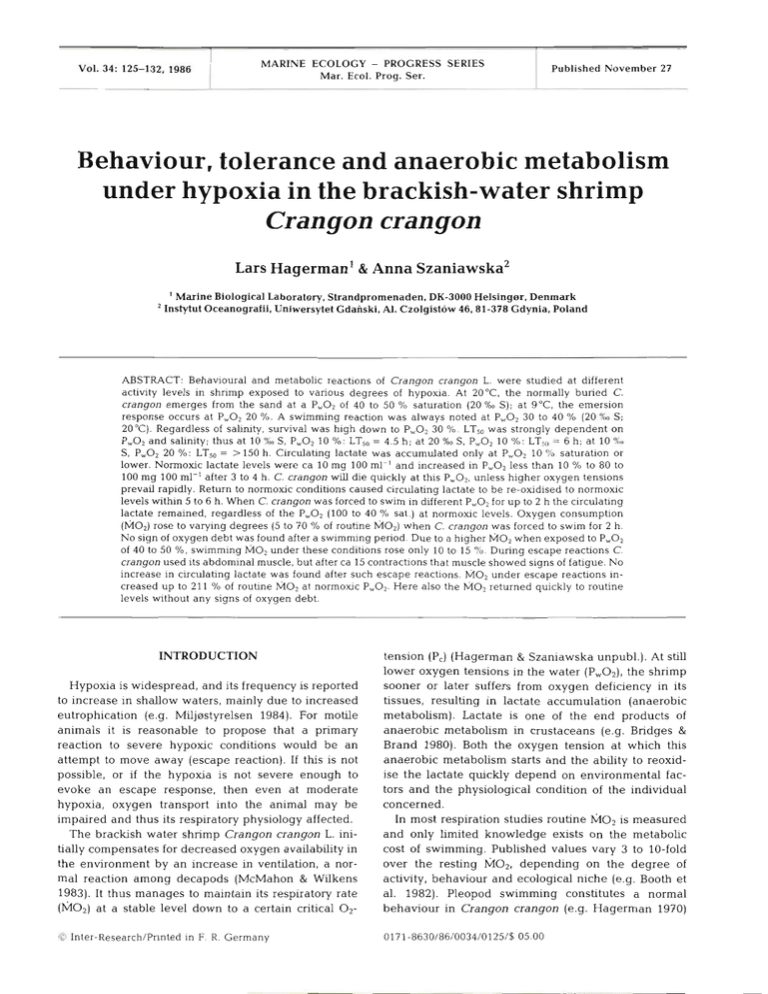
MARINE ECOLOGY - PROGRESS SERIES Mar. Ecol. Prog. Ser. Vol. 34: 125-132, 1986 Published November 27 Behaviour, tolerance and anaerobic metabolism under hypoxia in the brackish-water shrimp Crangon crangon Lars ~ a g e r m a n & ' Anna szaniawska2 I Marine Biological Laboratory, Strandprornenaden, DK-3000 Helsinger, Denmark Instytut Oceanografii, Uniwersytet Gdanski, Al. Czolgistbw 46,81-378 Gdynia, Poland ABSTRACT: Behavioural and metabolic reactions of Crangon cranyon L. were studied at different activity levels in shrimp exposed to various degrees of hypoxia. At 20°C, the normally buried C. crangon emerges from the sand at a P,Oz of 40 to 50 % saturation (20 %O S); at 9°C the emersion response occurs at PwOz20 %. A swimming reaction was always noted at P,Oz 30 to 40 O/O (20 %o S; 20°C). Regardless of salinity, survival was high down to P,Oz 30 %. LT,, was strongly dependent on P,02 and salinity; thus at 10 %. S, P,Oz 10 %: LTso = 4.5 h; at 20 %O S. PwO, 10 %: LTSo= 6 h; at 10 %. S, Pw0220 %: LT5, = > 150 h. Circulating lactate was accumulated only at P,"02 10 % saturation or lower. Normoxic lactate levels were ca 10 mg 100 ml-' and increased in P . 0 2 less than 10 % to 80 to 100 mg 100 ml-' after 3 to 4 h. C. crangon will die quickly at this P,02, unless higher oxygen tensions prevail rapidly. Return to normoxic conditions caused circulating lactate to be re-oxidised to normoxic levels within 5 to 6 h. When C. crangon was forced to swim in different P , 0 2for up to 2 h the circulating lactate remained, regardless of the P,02 (100 to 40 % sat.) at norrnoxic levels. Oxygen consumption (MO,) rose to varying degrees (5 to 70 % of routine MO,) when C. crangon was forced to swim for 2 h. No sign of oxygen debt was found after a swimming period Due to a higher MOz when exposed to Pw02 of 40 to 50 %, swimming MO2 under these conditions rose only 10 to 15 % . During escape reactions C. crangon used its abdominal muscle, but after ca 15 contractions that muscle showed signs of fatigue. No increase in circulating lactate was found after such escape reactions. MO2 under escape reactions increased up to 21 1 % of routine MO, at normoxic P,O,. Here also the MO2 returned quickly to routine levels w~thoutany signs of oxygen debt. INTRODUCTION Hypoxia is widespread, and its frequency is reported to increase in shallow waters, mainly due to increased eutrophication (e.g. Miljerstyrelsen 1984). For motile animals it is reasonable to propose that a primary reaction to severe hypoxic conditions would be an attempt to move away (escape reaction). If this is not possible, or if the hypoxia is not severe enough to evoke an escape response, then even at moderate hypoxia, oxygen transport into the animal may be impaired and thus its respiratory physiology affected. The brackish water shrimp Crangon crangon L. initially compensates for decreased oxygen availability in the environment by an increase in ventilation, a normal reaction among decapods (McMahon & Wilkens 1983). It thus manages to maintain its respiratory rate ( I 4 0 2 ) at a stable level down to a certain critical 0 2 Q Inter-ResearchIPnnted in F. R. Germany tension (P,) (Hagerman & Szaniawska unpubl.). At still lower oxygen tensions in the water (P,02), the shrimp sooner or later suffers from oxygen deficiency in its tissues, resulting in lactate accumulation (anaerobic metabolism). Lactate is one of the end products of anaerobic metabolism in crustaceans (e.g. Bridges & Brand 1980). Both the oxygen tension at which this anaerobic metabolism starts and the ability to reoxidise the lactate quickly depend on environmental factors and the physiological condition of the individual concerned. In most respiration studies routine M o 2 is measured and only limited knowledge exists on the metabohc cost of swimming. Published values vary 3 to 10-fold over the resting MO2, depending on the degree of activity, behaviour and ecological niche (e.g. Booth et al. 1982). Pleopod swimming constitutes a normal behaviour in Crangon crangon (e.g. Hagerman 1970) 126 Mar. Ecol. Prog. Ser. a n d hence could be supposed to increase the routine MO2 only to a moderate degree. On the other hand, violent activity outbursts during escape reactions, i.e. w h e n the shrimp uses its powerful abdominal muscle, could b e expected to increase rapidly the MO2 and to lead to fatigue within a short time due to the high amounts of energy needed. The purpose of this investigation is to study the behavioural and metabolic reactions of Crangon crangon, a t different activity levels, to various degrees of hypoxia. MATERIALS AND METHODS Crangon crangon were collected by a man-powered minitrawl in the Roskilde-Isefjord (Denmark) at a water depth of 0.5 to 1.5 m during late summer/early autumn 1985 (20°C; 20 %O S). Upon return to the laboratory Crangon crangon was stored in running seawater (20 %O S) for at least 1 wk before experimentation. All storage aquaria had a sand substrate. The shrimps were fed (bivalves, mysids, worms or other shrimp), but received no food during respiration experiments. For behaviour and tolerance experiments at least 20 shrimp were used per salinity/oxygen combmation. Survival was tested by keeping Crangon crangon at 20°C (summer temperature) in combinations with different P,02 (5, 10, 20, 30 % saturation) and salinities (5, 10, 20 %O S), i.e. under conditions that local populations might encounter (Muus 1967). After 3 h, mortality was recorded every 10 min and once per hour; after 12 h, mortality was recorded daily. Oxygen tensions in the water were decreased by bubbling with N2 and monitored either via a Radiometer oxygen electrode E 5047 connected to a n acid-base analyser PHM 71 or via a YSI model 58 oxygen meter. Blood samples from Crangon crangon were taken in 30 min or shorter intervals from the heart region by carefully inserting a hypodermic needle, collecting 5 to 100 p1 haemolymph depending on body size. Each shrimp was sampled only once. Haemolymph lactate was determined using Boehringer Test Combination no. 124842. Absorbance was read against the reagent blank at 340 nm using a Unicam SP 1800 UV-spectrophotometer. L-lactate concentration was calculated according to the values provided in the test combination table. These values were checked using an Llactate cahbration standard. Graham et al. (1983) suggested that the end point of the reaction for lactate analysis is unstable due to interferences from the C u + + ions liberated into the sample when the haemocyanin in the preparation procedure is precipitated by perchloric acid. Lowenng of the pH of the glycine/hydracine buffer (Sigma Chemical CO) from 9.2 to 9 with HC1 and 12 mM EDTA completely eliminates this interference (Engel & Jones 1978) and produces a stable end point. However the Boehringer Test Set has a glycine/hydracine buffer with a pH of 9.0 and stable end points have been obtained without the use of EDTA (see also Johnson 1985). Oxygen consumption rates (MO2)were measured in a flow-through system where oxygen tension of thermostatted water entering and leaving the respiration chamber was monitored continuously by 2 Radiometer E 5047 electrodes connected to 2 acid-base PHM 71 analysers and a Goerz Servogor 220 recorder. Water was pumped via a Cole-Palmer peristaltic pump and tygon tubing was used. The flow rate was adjusted to give a MO, of around 15 % of the available oxygen, normally this meant a flow of 1.2 to 3.2 m1 min-l, depending on the size of the shrimp. The respiration chamber was 8 cm long and 2.5 cm in diameter (internal measurements). A thin layer of sand was used as substrate in the respiration chamber (unless otherwise stated). The sand was changed before each experiment. Blank measurements without Crangon crangon were run frequently to calibrate and check the electrodes. Swimming MO2 was obtained by keeping the respiration chamber horizontal and slowly rotating it 135" to each side (powered by a small electric motor) so that the sand was moving and Crangon crangon was forced to swim. To obtain M o ~when C. crangon was using its abdominal muscle the shrimp was manually hit or irritated on its abdomen by a paddle-bent steel tread inserted into the respiration chamber through a gastight port. The experimentor operated and controlled the 'paddle' so the shrimp could be observed while it continued to jump for a s long a period a s possible. RESULTS Behaviour in relation to oxygen tensions A considerable change in oxygen tension (PWO2) always evoked a behavioural response in Crangon crangon. Normally, when adapted to a given set of environmental conditions during daytime and allowed to settle after handling, the shrimp buried itself in the sand. When P,+02was rapidly lowered (15 min) at 20°C and 15 %O S, C. crangon initially raised its front end out of the sand and emerged from the sand at 40 to 50 % PwOz.At 9"C, the corresponding P w 0 2was ca 20 %. An increase in general activity of the shrimp could be observed when P w 0 2was further lowered. At a temperature of 20°C considerable 'restlessness' was noted after emergence from the substrate, but at a P w 0 2of 30 '10 or lower the shrimps became immobile. The Hagerman & Szaniawska: Behav~our,tolerance and metabolism of Crangon crangon restlessness must be interpreted as an escape or avoidance reaction and was always in the form of swimming, but not by using the abdominal muscle. If the hypoxia persisted for a longer time, C. crangon emerged from the sand at a higher Pw02than if the P,Oz was rapidly lowered; at Pw02 60 % and 20°C, emergence occurred after 2.5 h. Table 1 Crangon crangon. LT,, (h) as a function of oxygen tensions (PWO2:saturation) in different salinities at 20 'C Oxygen tolerance Results of oxygen/salinity/ten~perature tolerance tests are shown in Fig. 1A & B, and in Table 1. Shrimp were considered dead when they turned opaque and no response was seen after transfer to oxygenated seawater. Survival was, regardless of salinity, good in . 12 0 , P,.02 down to and including 30 '10 saturation. Some mortality was noted in P,,Oz 30 %, but mostly only for moulting individuals (m in Fig. 1 ) .In 20 %O S, the correlation between P,02, time and survival was r = 0.99; for survival and P,"02, r = 0.88; for survival and time. r = 0.98. The response of Crangon crangon to low P w 0 2 is sudden and total: either survival extends over the whole experimental period or death occurs within a few hours. This is seen in the calculations of LTSo (Table 1) showing that this strongly depends on Pw02 and salinity. At 5 %O S, LT5,) in P w 0 2 10 OO/ was only 1.5 h, increasing to 70 h in P w 0 220 OO/ and to more than 150 h in P w 0 230 O/O. In 10 and 20 %X S, LT50 in P w 0 2 10 % increased to 4.5 and 6 h respectively. All other combinations tested resulted in LT50 extending the experimental period (up to 150 h). 96 hours Lactate accumulation in relation to PwOz Crangon crangon were kept in various oxygen tensions for up to 25 h (very low P,"02 until death), and at intervals sampled for circulating lactate. Resulting lactate concentrations (means f SE) are shown in Fig. 2. Controls from normoxic shrimp revealed a mean basic lactate concentration of less than l 0 mg 100 ml-' throughout the experiment. Circulating lactate showed generally a low level close to the control values down to a very low PWO2.An apparent increase in lactate was observed around half-saturation, and at P w 0 2 20 to 30 % the average lactate level was just under 20 mg 100 ml-l. An apparent increase in circulating lactate was not evident until P w 0 2 was below 10 % (mean 80 mg 100 ml-') but this is also, as shown above, within the lethal P,02 range. Lactate exhibited a rather pronounced variability due to intraspecific variation (moult stage) and, to some extent, to dilution of some very small haernolymph samples. When Crangon crangon was kept at P,Oz 30 to 100 O/O for 25 h, no increase in circulating lactate was observed. Only at P,OZ 10 % or less did obvious anaerobic metabolism (i.e. accun~ulationof circulating --v 0 0 12 36 hours 96 Fig. 1. Crangon crangon. (A) Survival as a function of time upon exposure to different levels of hypoxia; 20 %O S, 20°C. (1) P,02 5 % saturation; (2) P,02 10 %; (3) P,O2 20 '10; (4) P,02 30 %; (5)Pw02 50 %; n = 20 for each PWO2;m: moulting during experiment. (B) Survival as a function of time upon exposure to various levels of salinity and hypoxia; 5 and 10 %O S, 20°C. (1) 5 X. S, P,,.02 10 %; (2) 5 %O S, P,,02 20 %; (3) 5 ?LS, Pw0230 '10; (4) 10 960 S, P,,,O?10 %; (5) 10 %a S, P,,02 20 % ; (6) 10 4100 S, PWOZ 30 % ; n = 20 for each PwOz and salinity combination 128 C Q Mar Ecol. Prog. Ser. 34: 125-132, 1986 - -05 5 44 4 - X 12 10- 12 f 7 10 50 PW 0 2 , % sat. 100 Fig. 2. Crangon crangon. Haemolymph lactate accumulation (means t SE) upon exposure to various levels of P,O,. Number of samples noted at the respective P,02 values . 50. S 10. .. • • 10 .- hrs in hypoxia S • 0 0 10 24 Fig. 3. Crangon crangon. (A) Haemolymph lactate accumulation as a function of Ume upon exposure to P,02 less than 10 % saturation; 20 %. S, 20°C. (B) Haernolymph lactate re-oxidation as a function of time under normoxic conditions after 2 h exposure to P,02 less than 10 % saturation; 20 %O S. 20°C h r s in n o r m o x i a lactate) occur (Fig. 3A). After a low initial value lactate rose sharply to ca 100 mg 100 ml-' after 3 to 4 h in an apparently linear increase. C. crangon die at this P w 0 2 unless more normoxic conditions occur rapidly. Return to normoxic condtions caused circulating lactate to be reoxidised rapidly (Fig. 3B) returning to approximately normoxic levels after 5 to 6 h. Lactate accumulation, oxygen consumption and energy demand during swimming To investigate whether any increase in circulating lactate occurred during swimming, Crangon crangon was forced to swim for up to 2 h in different levels of P,02. Regardless of the P,02, lactate remained close to the range for normoxic shrimp (14.24 mg 100 ml-l; SE = 2.51; n = 19). At P w 0 2down to ca 40 % saturation, C. crangon were swimming during at least part of the experiment, while at lower tensions the shrimp were totally inactive and just passively turned around as the experimental chamber rotated. Thus under hypoxia as well as under normoxia no signs of anaerobic metabolism caused by swimming activity were evident in the blood; the shrimp either swam (at higher P,Oz) or remained inactive (lower P,02). When Crangon crangon were forced to swim in the experimental chamber, hhOz rose to varying degrees, from ca 5 % increase of routine MO2 up to 70 % Hagerman & Szaniawska: Behaviour, tolerance and n~etabolismof Crangon crangon increase (mean increase 24.6 %; SD +- 18.6 '10; n = 29). Relative changes in MO, during different types of activity and in different P,Oz are shown in Fig. 4. Examples of MOz and cost of swimming, expressed as C-units, are given in Table 2. The routine MO, here is indicative of a specimen well adapted to the experimental chamber: not totally inactive but moving, turning etc. at irregular intervals. In the active phase swimming intensity varies, from almost no swimming at all to swimming during the greater part of the experiment (up to 2 h). The shrimp listed in Table 2 were swimming for the greater part of the experiment. During swimming Crangon crangon uses only part of its energy resources; swimming thus is a normal event in die1 activity patterns. There was a tendency towards a higher cost of swimming in smaller specimens (Table 2). As seen from the table, the cost of swimming represents only a small part of the total metabolic cost and varies from a negligible amount to 70 % of the energy used. A swimming period of up to 2 h resulted in no lactate accumulation (see above). When swimming stopped, 45 - 50 100 o , % sat. W 2 P Fig. 4. Crangon crangon. Mean percentage change from routine MOz during swimming and during escape reactions (maximal activity) at normoxia (PwOz100 % saturation) and during hypoxia (Pw0245 to 50 % saturation); 20 %O S, 20°C MO;, returned to - or even decreased below - routine levels within a very short time. In some cases Crangon crangon was unable to swim for such long periods and just passively followed the movements of the rotating 2 to routine chamber. Also in these cases ~ 0 returned rates within minutes. Under hypoxic conditions (P,Oz 40 to 50 %) Crangon crangon was normally more active (p. 126; Hagerman & Szaniawska unpubl.) and thus the 'routine' - which in this case was an 'active' - M 0 2 was higher at this P w 0 2than at normoxia. Consequently, in shrimp forced to swim was only 10 to 15 OO/ higher than under normoxia (Fig. 4). Lactate accumulation and oxygen consumption during escape reactions Maximal amounts of energy are required in very short periods of time when Crangon crangon use their abdominal muscle which is specialised to perform powerful contractions, so that the shrimp 'jump' away, for instance from predators. Circulating lactate was measured after forcing the shrimps to jump in air or in the experimental chamber. The abdominal muscle fatigued very quickly; after ca 15 contractions the muscle no longer reacted to stimuli, and blood samples were taken. No increase in the circulating lactate was found. The mean level was 10.9 mg 100 ml-' (SE = 1.6; n = 7), i.e. the same level as for controls at rest. Upon escape reactions MO2 increased much more than due to swimming. Continuous 'irritation' of Crangon crangon in the experimental chamber gave an increase in routine MOz of u p to 211 % at normoxic PWO2.Also here the individual variation was very large (mean 76 %; SD = 62 %; n = 13). If MO, increase was transformed into C-units these outbursts of activity cost up to 0.22 mg C g-' h-'. However, energy expenditure might not be reflected directly in MO,;such violent muscle movements, performed within very short periods of time, could also b e based on mechanisms not requiring oxygen. 'Irritation' of the abdominal Table 2. Crangon crangon. Energy cost of swimming under normoxic conditions; 20 % S, 20°C; MOz expressed as mg O2 g-'h-' 0.375 mg C) and converted to mg C g-'h-' ( R Q = 0.85, 1 mg 0 2 = Weight g) (W Wt, 2.0 0.9 0.6 0.45 0.3 0.17 0.09 Routine MO2 (mg o2g-'h-') (mg C g-'h-') 0.24 0.39 0.53 0.502 0.95 0.67 2.45 0.076 0.12 0.17 0.16 0.30 0.21 0.78 Swimming MO2 (mg C g-'h-') Cost of swimming (mg C g-'h-') % change in MO,, from 0.091 0.19 0.188 0.23 0.42 0.29 0.86 0.015 0.07 0.018 0.07 0.12 0.08 0.08 19 58 5 43 40 38 10 routine to swimming Mar Ecol. Prog. Ser. 34: 125-132, 1986 muscle continued until the muscle no longer showed any reactions at all to stimuli, normally after 15 to 20 min. MO2 stabilised at the same time; it quickly returned to routine levels without any signs of an oxygen debt. DISCUSSION While it has long been suggested that crustaceans may detect and avoid hypoxic conditions, this has never been well documented. Gammarus oceanicus and Crangon septemspinosa have been shown to respond with an avoidance reaction to anoxic conditions (Cook & Boyd 1965, Haefner 1971), and the brackish water shrimp Palaemonetes varians increased its swimming activity when P w 0 2decreased and even tried to jump out of the water (Hagerman & Uglow 1984). Nephrops norvegicus emerged from its burrow when PWO2reached 25 % (Hagerman & Uglow 1985).It seems thus reasonable to assume that (1) increasing activity to move away - and where this is not possible and/or the hypoxia severe - (2) inducing a change to a n activity level as low as possible in order to conserve available energy, represent general phenomena in crustaceans exposed to varying oxygen tensions. Oxygen tolerance (LTs0) in such species is normally high and related to their ability to move. More or less sessile species, e.g. bivalves, show an considerably higher than crustaceans. Crangon crangon from Kiel Bay exhibited an LT50 to anoxia at 10°C of 2 h (Dries & Theede 1974), and this corresponds well with our results. Sedgwick (1981) investigated C. crangon from the polluted Thames estuary. Due to the techniques applied his results are difficult to interpret but they show at least that C. crangon from the Thames estuary tolerates and reacts to hypoxia at slightly lower levels than found for our C. crangon from the Danish fjords, and from Kiel Bay. Obviously - and also evident from our results - the tolerance to hypoxia is salinity dependent: the higher the salinity (<20 %O S) the lower the Pw02 that can be tolerated at comparable temperatures. As C. crangon is isosmotic to the medium at ca 25 %O S (Hagerman 1971, Spaargaren 1971) it is probable that this shrimp possesses a high tolerance to low P w 0 2in this salinity. Blood lactate is always detectable in Crangon crangon. Its values correspond to similar levels in other crustaceans (Bridges & Brand 1980, Agnew & Taylor 1985) and is just below 10 mg%. Anaerobic metabolism dominates when oxygen no longer can fuel the basal metabolism in the tissues. In C. crangon this point is approached very abruptly (Pw02< 10 %), indicating a high ability to extract and use available oxygen down to this P,02. Pritchard & Eddy (1979) and Bridges & Brand (1980) suggested that lactate accumu- lation and subsequent reoxidation is related to the general ecology of the species, so that burrowing animals, or other animals likely to be subjected to anaerobic conditions, have a faster reoxidation rate. Accumulation of lactate presumably starts at a lower P,02 in species that can maintain their MO2 stable at a lower P,,02 than in animals not subjected to fluctuating Pw02. In C. crangon lactate accumulates only under potentially lethal conditions so that, unless more favourable oxygen conditions occur within 1 to 2 h, the shrimp will die. The lactate accumulation rate found in this investigation is very fast compared to that in Nephrops norvegicus and Corystes cassivelanus (Bridges & Brand 1980) but this is certainly due to the higher temperature (20 versus 10°C). The time for re-oxidation of the lactate is considerably shorter in the burrowing/digging Carcinus maenas, Corystes cassivelanus and Crangon crangon than in the non-burrowing Galathea stngosa and Homarus gammarus (Bridges & Brand 1980, Johnson 1985).In C. crangon and other digging forms re-oxidation terminates, despite the above-mentioned difference in experimental temperature, in 5 to 6 hours. According to Hochacka & Somero (1973) this ability to convert lactate back to glucose is necessary to tolerate high lactate levels; thus species like C. crangon which can rapidly accumulate lactate under near-anoxia have the mechanism to use it quickly in gluconeogonesis under normoxia. If reoxidation was slower, then lactate would never be completely reoxidised to normoxic levels, as severe hypoxia under summer conditions might appear at die1 intervals (Muus 1967). The lack of lactate accumulation even during continuous normal swimming shows that aerobic resources are adequate to supply the necessary energy for swimming during normoxia and moderately hypoxic conditions. Even if more severe hypoxia occurs, Crangon crangon responds to this not by turning to an anaerobic metabolism but by ceasing activity. Available literature suggests that the energetic cost of swimming varies considerably. Increase in M02 depends, among other things, on activity level, environmental factors, biology of the animal concerned and its body shape. The blue crab Callinecfes sapidus increases its MO, 2.6-fold over routine levels during 'moderate' swimming (Booth et al. 1982). However, this type of blue crab response should be referred to as escape swimming since the normal activity of such a crab is walking. There is further evidence that such blue crab activity is near maximum activity: severe metabolic acidosis occurred with strong lactate accumulation in the haemolymph (Booth et al. 1982). The metabolic cost of walking would thus be considerably less in C. sapidus and perhaps comparable to the cost of swimming in C. crangon, i.e. up to 70 % Hagerman & Szaniawska: Behaviour, tolerance and metabolism of Crangon crangon increase in routine MOz. Body shape in relation to medium viscocity presumably reduces the energy requirements for swimming C. crangon compared to swimming of blue crab. This is also shown by the low metabolic cost for swimming in a planktonic copepod: less than 1 % of basal metabolism (Vlymen 1970). The 'aerobic scope' for C. crangon should thus be considerably higher than indicated by swimming MO2 in relation to routine MO,. Aerobic metabolic scope of 4-fold the quiescent rate has been found for, among others, Cancer magister (McMahon et al. 1979). Dall (1986) showed that Penaeus esculentus increased its h;i02 by -130 % when changing its activity level from resting (standard) to swimming. Von Oertzen (1979) found for Palaemon adspersus an increase in MO, at 15 to 20°C of 20 to 60 % when that shrimp exhibited 'spontaneous' activity, i.e. swimming, and these values are comparable to what w e found for C. crangon. Repayment of a n oxygen debt will only occur if the hypoxic conditions have been below the P,. Consequently, no oxygen debt was noted for Crangon crangon after a period of swimming activity or after exposure to moderate hypoxia as no end products due to anaerobic metabolism had accumulated. Maximum activity of Crangon crangon and other shrimp, i.e. short outbursts when using the abdominal muscle, cause an increase in MO;, up to 211 %, with large individual variations. Onnen & Zebe (1983) showed that C. crangon during such exercises used enormous amounts of energy within a very short time, and this manifests itself only partly in immediate hdOz changes. The abdominal muscle contains a large quantity of phosphagen, and the energy need of the muscle results in a considerable decrease of phosphoarginine until near-depletion. Oxygen supply via haemolymph is not sufficient for these outbursts; instead the shrimp relies on its phosphagen store. When this store is used, fatigue sets in after ca 15 muscle contractions. Increase in MO2 is thus partly a result of a considerable increase in whole-body activity, and partly of processes of reconstituting the phosphagen store as quickly as possible. Circulating lactate did not increase during such exhausting activity, and this corresponds to results of Onnen & Zebe (1983) who found no remarkable haemolymph lactate increase due to work in C. crangon. However, they noted a considerable lactate increase in tail muscle tissue. Thus during 'normal' activity there is always enough oxygen available in the medium and in the haemolymph for the metabolic needs of the tissues, while during exhausting exercises the enormous energy requirements of Crangon crangon quickly deplete the stores and fatigue sets in. Under hypoxia during 'normal' activity, fatigue sets in after a period of swimming without C. crangon having to turn to anaerobic metabolism. The ecological consequences of this would b e a decreased general activity level during long periods of moderate hypoxia and a decreased ability to avoid predators such as fishes and birds. During very severe hypoxic periods C. crangon turns to anaerobic metabolism, but at summer temperatures in brackish water this will be lethal within a few hours. Acknowledgement. This investigation was performed a t the Marine Biological Laboratory, Helsingar (Denmark) while one of us (A. Sz.) was in receipt of a fellowship from the Polish State. LITERATURE CITED Agnew, D. J., Taylor, A. C. (1985). The effect of oxygen tension on the physiology and distribution of Echinogrammarus pirloti (Sexton & Spooner) and E. obtusatus (Dahl) (Crustacea: Amphipoda). J. exp. mar. Biol. Ecol. 87: 169-190 Booth, C. E., McMahon, B. R., Pinder, A. W. (1982). Oxygen uptake and the potentiating effects of increased hemolymph lactate on oxygen transport during exercise in the blue crab (Cahnectes sapidus). J . comp. Physlol. 148: 111-121 Bridges, C. R., Brand, A. R. (1980).The effect of hypoxla on oxygen consumption and blood lactate levels of some marine crustacea. Comp. Biochem. Physiol. 65 A: 3 9 S 4 0 9 Cook, R. H., Boyd, C. M. (1965).The avoidance by Cammarus oceanicus Segerstrdle (Amphipoda, Crustacea) of anoxic regions. Can. J. 2001. 43: 971-975 Dall, W . (1986). Estimation of routine metabolic rate in a p e n ~ i dprawn, Penaeus esculentus Haswell. J. exp. mar. Biol. Ecol. 96: 57-74 Dries, R. R., Theede, H. (1974). Sauerstoffmangelresistenz mariner Bodenevertebraten aus der westlichen Ostsee. Mar. Biol. 25: 327-333 Engel, P., Jones, J. B. (1978). Causes and elimination of erratic blanks in the enzymatic metabolic assays involving the use of NAD* in alkaline hydrazine buffers: improved conditions of the assay of L-glutamate, L-lactate and other metabolites. Analyt. Biochem. 88: 475-484 Graham, R. A., Mangum, C. P,, Terwilliger, R. C.. Terwilliger, N. B. (1983). The effect of organic acids on oxygen binding of hemocyanin from the crab Cancer magister. Comp. Biochem. Physiol. 74 A: 45-50 Haefner, P. A. (1971). Avoidance of anoxic conditions by the sand shrimp, Crangon septemspinosa Say. Chesapeake Science 12: 50-51 Hagerman, L. (1970). Locomotory activity patterns of Crangon vulgans (Fabr.) (Crustacea, Natantia). Ophelia 8: 2 5 5 2 6 6 Hagerman, L. (1971). Osmoregulation and sodium balance in Crangon vulgaris (Fabr.) (Crustacea, Natantia) in varying salinities. Ophelia 9: 21-30 Hagerman, L., Uglow, R. F. (1984). The influence of hypoxia on the blood regulation of the braclush water shrimp Palaemonetes varians Leach. J. exp. mar. Biol. Ecol. 76: 157-165 Hagerman, L., Uglow, R. F. (1985). Effects of hypoxia on the respiratory and circulatory regulation of Nephrops norwegicus. Mar. Biol. 87: 273-278 Hochacka, P. W., Somero, G. N. (1973).Strategies of biochemical adaptation. Saunders, Philadelphia Johnson, I. T. (1985). Studies on some responses of Carcinus Mar Ecol. Prog. Ser 34: 125-132. 1986 m a e n a s (L.) and other brachyurans to hypoxic and aerial exposure. Ph. D. thesis, Univ. of Hull McMahon, B. R., McDonald, D. G., Wood, C. M. (1979). Ventilation, oxygen uptake and haemolymph oxygen transport, following enforced exhausting activity in the dungeness crab Cancer magister. J. exp. Biol. 80: 271-285 McMahon, B. R., Wilkens, J. L. (1983). Ventilation, perfusion and oxygen uptake. In: Mantel, Linda, H. (ed.) The biology of Crustacea, Vol. 5. Internal anatomy and physiological regulation. Academic Press, New York, p. 289-372 Miljsstyrelsen (1984). Iltsvind og fiskedsd i 1981. Omfang og brsager. Ministry of Environmental Protection, Copenhagen Muus, B. J. (1967). The fauna of Danish estuaries and lagoons. Meddr Danm. Fisk.-og Havunders. N. S. 5: 1-316 von Oertzen, J.-A. (1979). Versuch einer kausalokologischen Leistungsanalyse a n brackwasserlebenden Tieren. Thesis, Wilhelm-Pieck-Universitiit, Rostock, GDR Onnen, T., Zebe, E. (1983). Energy metabolism in the tail muscles of the shrimp Crangon crangon during work and subsequent recovery. Comp. Biochem. Physiol. 74 A: 833-838 Pritchard. A. W.. Eddv, ' . S. 119791. . , Lactate formation in Callianassa californiensis and Upogebia pugettensis ICrustacea: Thalassinideal. Mar. Biol. 50: 2 4 S 2 5 3 ~ e d ~ w i cR. k .W. (1981). The Survival, behaviour and respiratory physiology of Crangon crangon (Fabr.) in the polluted Thames estuary. In: Jones, N. V., Wolff, W. J. (ed.) Feeding and sunival strategies of estuarine organisms. Plenum Press, London, p. 123-133 Spaargaren, D. H. (1971). Aspects of the osmotic regulation in the shrimps Crangon crangon and Crangon allrnanni. Neth. .I.Sea Res. 5: 275-333 Vlymen, N. J. (1970). Energy expenditure of swimming copepods. Limnol. Oceanogr. 15: 34S356 This article was submitted to the editor; it was accepted for printing on September 10, 1986
